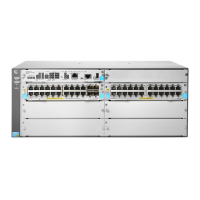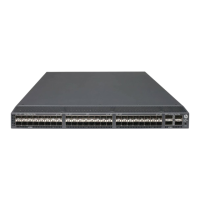24
Purpose Command
associated with the status of the specified port. interface-type interface-number ]
Display the one-way DM result on the specified
MEP.
display cfd dm one-way history
[
service-instance
instance-id [
mep
mep-id ] ]
Display LTR information received by a MEP.
display cfd linktrace-reply
[
service-instance
instance-id
[
mep
mep-id
] ]
Display the content of the LTR messages received
as responses to the automatically sent LTMs.
display cfd linktrace-reply auto-detection
[
size
size-value
]
Display MD configuration information.
display cfd md
Display the attribute and running information for the
MEPs.
display cfd mep
mep-id
service-instance
instance-id
Display MEP list in a service instance.
display cfd meplist
[
service-instance
instance-id
Display MP information.
display cfd mp
[
interface
interface-type
interface-number ]
Display information about a remote MEP.
display cfd remote-mep service-instance
instance-id
mep
mep-id
Display service instance configuration information.
display cfd service-instance
[ instance-id ]
Display CFD status.
display cfd status
Display the TST result on the specified MEP.
display cfd tst
[
service-instance
instance-id [
mep
mep-id ] ]
Clear the one-way DM result on the specified MEP.
reset cfd dm one-way history
[
service-instance
instance-id [
mep
mep-id ] ]
Clear the TST result on the specified MEP.
reset cfd tst
[
service-instance
instance-id [
mep
mep-id ] ]
CFD configuration example
Network requirements
As shown in Figure 5:
• The network comprises five devices and is divided into two MDs: MD_A (level 5) and MD_B
(level 3). All ports belong to VLAN 100, and the MAs in the two MDs all serve VLAN 100.
Assume that the MAC addresses of Device A through Device E are 0010-FC01-6511,
0010-FC02-6512, 0010-FC03-6513, 0010-FC04-6514, and 0010-FC05-6515, respectively.
• MD_A has three edge ports: Ten-GigabitEthernet 1/0/1 on Device A, Ten-GigabitEthernet 1/0/3
on Device D, and Ten-GigabitEthernet 1/0/4 on Device E, and they are all inward-facing MEPs.
MD_B has two edge ports: Ten-GigabitEthernet 1/0/3 on Device B and Ten-GigabitEthernet
1/0/1 on Device D, and they are both outward-facing MEPs.
• In MD_A, Device B is designed to have MIPs when its port is configured with low level MEPs.
Port Ten-GigabitEthernet 1/0/3 is configured with MEPs of MD_B, and the MIPs of MD_A can
be configured on this port. You should configure the MIP generation rule of MD_A as explicit.
• The MIPs of MD_B are designed on Device C, and are configured on all ports. You must
configure the MIP generation rule as default.
• Configure CC to monitor the connectivity among all the MEPs in MD_A and MD_B. Configure
LB to locate link faults, and use the AIS and EAIS functions to suppress the error alarms that
are reported.
• After the status information for the entire network is obtained, use LT, LM, one-way DM,
two-way DM, and TST to detect link faults.

